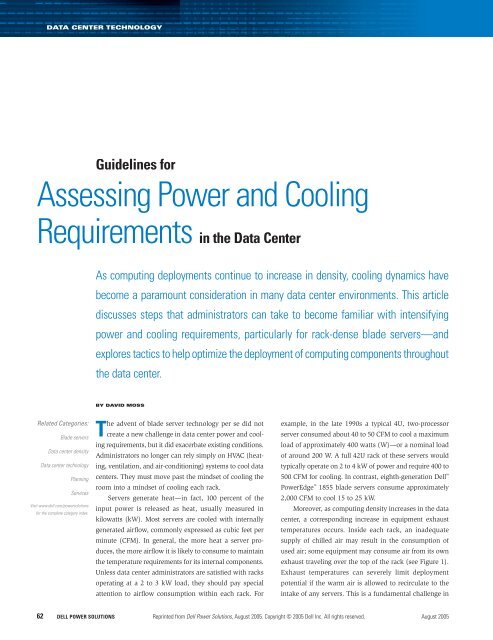POWER SOLUTIONS
POWER SOLUTIONS
POWER SOLUTIONS
Create successful ePaper yourself
Turn your PDF publications into a flip-book with our unique Google optimized e-Paper software.
DATA CENTER TECHNOLOGYGuidelines forAssessing Power and CoolingRequirements in the Data CenterAs computing deployments continue to increase in density, cooling dynamics havebecome a paramount consideration in many data center environments. This articlediscusses steps that administrators can take to become familiar with intensifyingpower and cooling requirements, particularly for rack-dense blade servers—andexplores tactics to help optimize the deployment of computing components throughoutthe data center.BY DAVID MOSSRelated Categories:Blade serversData center densityData center technologyPlanningServicesVisit www.dell.com/powersolutionsfor the complete category index.The advent of blade server technology per se did notcreate a new challenge in data center power and coolingrequirements, but it did exacerbate existing conditions.Administrators no longer can rely simply on HVAC (heating,ventilation, and air-conditioning) systems to cool datacenters. They must move past the mindset of cooling theroom into a mindset of cooling each rack.Servers generate heat—in fact, 100 percent of theinput power is released as heat, usually measured inkilowatts (kW). Most servers are cooled with internallygenerated airflow, commonly expressed as cubic feet perminute (CFM). In general, the more heat a server produces,the more airflow it is likely to consume to maintainthe temperature requirements for its internal components.Unless data center administrators are satisfied with racksoperating at a 2 to 3 kW load, they should pay specialattention to airflow consumption within each rack. Forexample, in the late 1990s a typical 4U, two-processorserver consumed about 40 to 50 CFM to cool a maximumload of approximately 400 watts (W)—or a nominal loadof around 200 W. A full 42U rack of these servers wouldtypically operate on 2 to 4 kW of power and require 400 to500 CFM for cooling. In contrast, eighth-generation Dell PowerEdge 1855 blade servers consume approximately2,000 CFM to cool 15 to 25 kW.Moreover, as computing density increases in the datacenter, a corresponding increase in equipment exhausttemperatures occurs. Inside each rack, an inadequatesupply of chilled air may result in the consumption ofused air; some equipment may consume air from its ownexhaust traveling over the top of the rack (see Figure 1).Exhaust temperatures can severely limit deploymentpotential if the warm air is allowed to recirculate to theintake of any servers. This is a fundamental challenge in62DELL <strong>POWER</strong> <strong>SOLUTIONS</strong> Reprinted from Dell Power Solutions, August 2005. Copyright © 2005 Dell Inc. All rights reserved. August 2005








